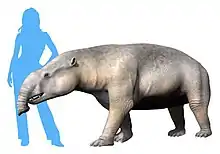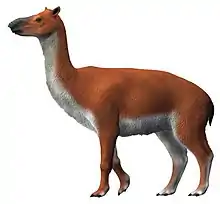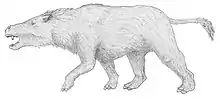Victorlemoinea
Victorlemoinea is an extinct litoptern genus of the family Sparnotheriodontidae, that lived from the Early to Middle Eocene. Fossils of Victorlemoinea have been found in the Las Flores, Sarmiento and Koluel Kaike Formations of Argentina, the Itaboraí Formation of Brazil and La Meseta Formation, Antarctica.[1]
| Victorlemoinea | |
|---|---|
| Scientific classification | |
| Domain: | Eukaryota |
| Kingdom: | Animalia |
| Phylum: | Chordata |
| Class: | Mammalia |
| Order: | †Litopterna |
| Family: | †Sparnotheriodontidae |
| Genus: | †Victorlemoinea Ameghino 1901 |
| Species | |
Description
Victorlemoinea was a medium-sized litoptern. Sparnotheriodon, Victorlemoinea, and one species of Notiolofos, N. arquinotiensis, have been estimated to have had masses of roughly 400 g (0.88 lb), whereas another species of Notiolofos, N. regueroi, was smaller, with a body mass estimated to have been between 25 and 58 kg, making them one of the largest litopterns of the Paleogene.[2] Litopterns would not retain such sizes again until the Miocene.[3]
Taxonomy
This animal is considered a member of the family Sparnotheriodontidae and is said to share some features with the mammal family Didolodontidae. Fossils referable to the genus have been found on Seymour Island, Antarctica.[4]
Victorlemoinea was first named by Florentino Ameghino in 1901 on the basis of a mandible and teeth from the Sarmiento Formation of Argentina, with the type species being Victorlemoinea labyrinthica.[5] In 1952, Carlos de Paula Couto named a new species of Victorlemoinea from the Itaboraí Formation of Brazil, V. prototypica.[6] In 1983, Richard Cifelli tentatively synonymized Sparnotheriodon with Victorlemoinea,[7] however, many other authors view the former as distinct.[8]
The following cladogram is based on Chimento & Agnolin, 2020, showing the position of Victorlemoinea.[9]
| Panperissodactyla |
| ||||||||||||||||||||||||||||||||||||||||||||||||||||||||||||||||||||||||||||||||||||||||||||||||||||||||||||||||||||||||||||
References
- Victorlemoinea at Fossilworks.org
- Vizcaíno, Sergio Fabián; Cassini, Guillermo; Toledo, Néstor (2012-05-01). On the evolution of large size in mammalian herbivores of Cenozoic faunas of South America. University of Chicago Press. pp. 76–101. ISBN 978-0-226-64921-4.
- Gelfo, Javier N.; López, Guillermo M.; Santillana, Sergio N. (2017). "Eocene ungulate mammals from West Antarctica: implications from their fossil record and a new species". Antarctic Science. 29 (5): 445–455. doi:10.1017/S0954102017000244. eISSN 1365-2079. ISSN 0954-1020.
- Francis, Jane E.; Pirrie, Duncan; Crame, J. Alistair (2006). Cretaceous-Tertiary High-latitude Palaeoenvironments: James Ross Basin, Antarctica. Geological Society of London. pp. 1–206. Retrieved 2017-09-29.
- Ameghino, Florentino (1901). "Notices préliminaires sur des ongulés nouveaux des terrains crétacès de Patagonie". Boletin de la Academia Nacional de Ciencias de Córdoba. 16: 349–429. OCLC 123174974.
- Paula Couto, Carlos, de (1952). "Fossil mammals from the beginning of the Cenozoic in Brazil. Condylarthra, Litopterna, Xenungulata, and Astrapotheria". Bulletin of the American Museum of Natural History. 99: 355–394. hdl:2246/417. OCLC 18189741.
{{cite journal}}: CS1 maint: multiple names: authors list (link) - Cifelli, Richard L (1983-11-09). "The Origin and Affinities of the South American Condylarthra and Early Tertiary Litopterna (Mammalia)". American Museum Novitates (2772): 1–49.
- Gelfo, Javier N. (June 2016). "Considerations about the Evolutionary Stasis of Notiolofos arquinotiensis (Mammalia: Sparnotheriodontidae), Eocene of Seymour Island, Antarctica". Ameghiniana. 53 (3): 316–332. doi:10.5710/AMGH.14.09.2015.2934. ISSN 0002-7014.
- Chimento, Nicolás R.; Agnolin, Federico L. (2020). "Phylogenetic tree of Litopterna and Perissodactyla indicates a complex early history of hoofed mammals". Scientific Reports. 10 (1): 13280. doi:10.1038/s41598-020-70287-5. hdl:11336/13573. ISSN 2045-2322. PMC 7413542. PMID 32764723.




.jpg.webp)



